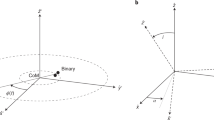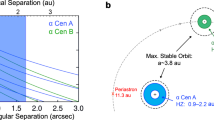Abstract
In the four years following the discovery of a planet orbiting the star 51 Pegasi, about 20 other planets have been detected through their influence on the radial velocities of lines in the stellar spectra. The orbital motion of the planet is detected through the smaller ‘reflex motion’ of the star, which can be measured using high-precision spectroscopy. This indirect technique cannot investigate the radius or composition of the planet, and can place only a lower limit on its mass. Here we report the probable detection of Doppler-shifted starlight reflected from the planet known to orbit τ Boötis with a period of just a few days. We find that the orbital inclination is about i = 29°, from which we infer that the mass is about eight times that of Jupiter. The planet has the size and reflectivity expected for a gas-giant planet.
This is a preview of subscription content, access via your institution
Access options
Subscribe to this journal
Receive 51 print issues and online access
$199.00 per year
only $3.90 per issue
Buy this article
- Purchase on Springer Link
- Instant access to full article PDF
Prices may be subject to local taxes which are calculated during checkout




Similar content being viewed by others
References
Mayor,M. & Queloz,D. A Jupiter-mass companion to a solar-type star. Nature 378, 355–359 (1995).
Butler,R. P., Marcy,G. W., Williams,E., Hauser,H. & Shirts,P. Three new 51 Pegasi-type planets. Astrophys. J. 474, L115–L118 ( 1997).
Butler,R. P., Marcy,G. W., Vogt,S. S. & Apps,K. A planet with a 3.1 day period around a solar twin. Publ. Astron. Soc. Pacif. 110, 1389–1393 (1998).
Fischer,D. A., Marcy,G. W., Butler,R. P., Vogt,S. S. & Apos,K. Planetary companions around two solar-type stars: HD 195019 and HD 217107. Publ. Astron. Soc. Pacif. 111, 50–56 (1999).
Donati,J.-F., Semel,M., Carter,B., Rees,D. E. & Collier Cameron, A. Spectropolarimetric observations of active stars. Mon. Not. R. Astron. Soc. 291, 658– 682 (1997).
Toner,C. G. & Gray,D. F. The starpatch on the G8 dwarf ξ Bootis A. Astrophys. J. 334, 1008– 1020 (1998).
Baliunas,S. L., Henry,G. W., Donahue,R. A., Fekel,F. C. & Soon,W. H. Properties of sun-like stars with planets: ρ1 Cancri, τ Bootis, and ν Andromedae. Astrophys. J. 474, L119– L122 (1997).
Charbonneau,D., Jha,S. & Noyes,R. W. Spectral line distortions in the presence of a close-in planet. Astrophys. J. 507, L153–L156 (1998).
Gray,D. F. Observational evidence against differential rotation in F stars. Astrophys. J. 258, 201–208 (1982).
Fuhrmann,K., Pfeiffer,M. J. & Bernkopf, J. F- and G-type stars with planetary companions: ν Andromedae, ρ1 Cancri, τ Bootis, 16 Cygni and ρ Coronae Borealis. Astron. Astrophys. 336, 942–952 (1998).
Gonzelez,G. Spectroscopic analyses of the parent stars of extrasolar planetary system candidates. Astron. Astrophys. 334, 221– 238 (1998).
Hilton,J. L. in Explanatory Supplement to the Astronomical Almanac (ed. Seidelmann, P. K.) 383–419 (University Science Books, Mill Valley, California, 1992).
Charbonneau,D. et al. An upper limit on the reflected light from the planet orbiting the star τ Bootis. Astrophys. J. 522, L145–L149 (1999).
Marcy,G. W. et al. The planet around 51 Pegasi. Astrophys. J. 481, 926–935 (1997).
Drake,S. A., Pravdo,S. H., Angelini,L. & Stern,R. A. Synchronization timescales for three solar-type stars that have Jupiter-mass companions in short-period orbits. Astron. J. 115, 2122–2124 (1998).
Guillot,T. et al. in IAU Colloquium 161: Astronomical and Biochemical Origins and the Search for Life in the Universe (eds Cosmovici, C. V., Bowyer, S. & Wertheimer, D.) 343–350 (Editrice Compositori, Bologna, 1997).
Acknowledgements
This work is based on observations with the 4.2-m William Herschel Telescope at the Observatori del Roque de los Muchachos on La Palma, and used Starlink-supported hardware and software.
Author information
Authors and Affiliations
Corresponding author
Rights and permissions
About this article
Cite this article
Cameron, A., Horne, K., Penny, A. et al. Probable detection of starlight reflected from the giant planet orbiting τ Boötis. Nature 402, 751–755 (1999). https://doi.org/10.1038/45451
Received:
Accepted:
Issue Date:
DOI: https://doi.org/10.1038/45451
This article is cited by
-
Water in Extrasolar Planets and Implications for Habitability
Space Science Reviews (2017)
-
The signature of orbital motion from the dayside of the planet τ Boötis b
Nature (2012)
Comments
By submitting a comment you agree to abide by our Terms and Community Guidelines. If you find something abusive or that does not comply with our terms or guidelines please flag it as inappropriate.



